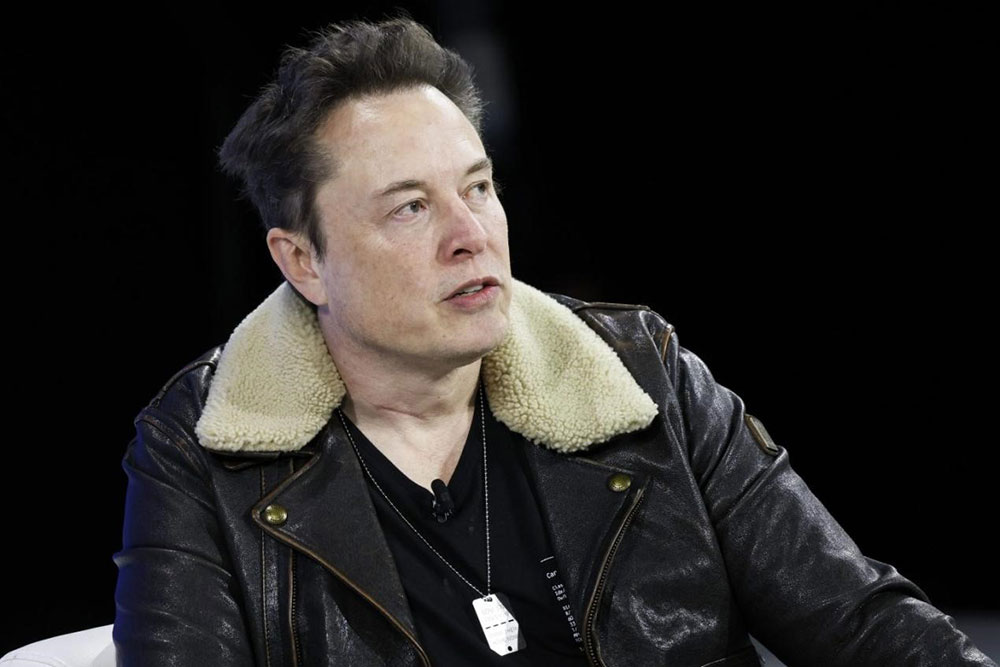
• 上周,特斯拉汽车在中国市场的销量骤降至3,070辆,创下自第二季度以来的最差单周表现,主要原因是新款Model Y车型的销量低迷。尽管此类高频数据存在波动性,但中国市场对特斯拉至关重要。该品牌在中国市场的七日销量超过欧洲主要国家数月的总销量。
中国市场的周销量数据揭示了一个令人担忧的趋势后,特斯拉万亿美元市值与销售和收益等基本面之间的鸿沟持续扩大。
周二,保险数据显示,截至5月11日,特斯拉电动汽车在中国市场的单周销量只有3,070辆,环比骤降58%,比去年同期下降了69%。
对特斯拉而言不幸的是,其产量较低的Model 3轿车销量大致保持稳定。此次销量下滑的原因来自新款Model Y,这款车型占全球交付量的三分之二,其单周销量仅有1,270辆,创2月下旬上市以来的最低纪录。
特斯拉投资者高度关注该高频数据,因为中国是特斯拉最大的单一市场,其重要性甚至超过美国。事实上,在中国市场七天的销量,甚至超过德国等欧洲主要国家七个月的总销量。
周销量数据本身存在波动性,如果单独来看,每周销量数据可能只是扭曲基本趋势的“噪音”而已。但仔细研究后你会发现,特斯拉自第二季度开始以来的累计销量较去年同期下滑25%,甚至弱于第一季度最初几周的表现,当时是中国市场的传统淡季。
销量下滑令特斯拉的支持者们感到不安,他们本来预期特斯拉的业绩现在会有明显好转。在基本面持续走弱的同时,特斯拉的市值却在持续增长,并在周一重新突破万亿美元大关。其明年的预期市盈率高达110倍,而2025年的预期市盈率更高达167倍。
经常发布特斯拉国际电动汽车销售数据的罗兰德·皮尔彻写道:“特斯拉中国市场的表现必有隐情。”
马斯克称并未看到需求下降
这可能预示着特斯拉遭遇了去年早些时候弗里蒙特工厂高效转产到Model 3 Highland车型时所面临的困难,或者说供应问题。从未有其他大型汽车公司尝试对一款全球销量超百万辆的车型进行中期改款,因此没有历史先例可以参考。
然而,在上月末的第一季度财报电话会议上,特斯拉高管们向投资者保证,新款Model Y在所有四家工厂的生产效率已赶上了旧车型——后者曾由熟练的装配线工人以节拍器般精准的节奏实现工业化规模量产。
如果供应不成问题,那么问题就归结于客户兴趣下降。只是特斯拉同样否认存在这方面的问题,因为第一季度的试驾次数创下历史新高。
马斯克在电话会议上表示:“排除宏观经济问题,我们并未看到需求下降。”他认为,唯一的罪魁祸首是与品牌或其产品无关的普遍低迷情绪。他解释称:“当经济存在不确定性时,人们往往会暂停购买大宗商品,比如买车。”
然而,即使规模远小于行业领头羊比亚迪(BYD)的中国国内电动汽车品牌,如蔚来(Nio)、小鹏(Xpeng)、理想(Li Auto)和小米(Xiaomi)等,都迎来了销量增长。这表明它们受到中美贸易谈判持续波动的影响较小。
“缺少新车型正在影响特斯拉在中国市场的表现”
汽车资讯网站CarNewsChina认为,特斯拉靠周期性小幅改进维持相同产品线的战略决策在中国市场已难以为继,无论公司祭出多少促销政策也无济于事。那些等待新版Model Y亮相的潜在客户发现,改款后的Model Y本质上仍是一款五年前的车型,对他们没有足够的吸引力。
反观小鹏G6、乐道(Onvo)L60、理想L6、比亚迪海狮7和极氪7X等中国品牌的跨界车型正加速赶超特斯拉。
这些本土品牌正以“中国速度”创新,将新车研发周期从行业常规的6-7年压缩至2-3年。与之形成鲜明对比的是,特斯拉至今未对任何车型进行彻底换代——即便是Model S,其底盘结构仍沿用了2012年首发版本。
相比之下,中国电动车普遍搭载800伏高压快充平台,理论充电速度是特斯拉400伏架构的两倍,并配备丰富的智能互联功能。它们不仅提供免费高阶智驾系统,其性能远超特斯拉的Autopilot,还额外附带一层“爱国情怀滤镜”作为加分项。
CarNewsChina在周二指出:“中国市场的竞争异常激烈。年轻消费者不像经历过上世纪90年代的父母一样对购买国货心存芥蒂。缺少新车型正在影响特斯拉在中国市场的表现。”(财富中文网)
译者:刘进龙
审校:汪皓
• 上周,特斯拉汽车在中国市场的销量骤降至3,070辆,创下自第二季度以来的最差单周表现,主要原因是新款Model Y车型的销量低迷。尽管此类高频数据存在波动性,但中国市场对特斯拉至关重要。该品牌在中国市场的七日销量超过欧洲主要国家数月的总销量。
中国市场的周销量数据揭示了一个令人担忧的趋势后,特斯拉万亿美元市值与销售和收益等基本面之间的鸿沟持续扩大。
周二,保险数据显示,截至5月11日,特斯拉电动汽车在中国市场的单周销量只有3,070辆,环比骤降58%,比去年同期下降了69%。
对特斯拉而言不幸的是,其产量较低的Model 3轿车销量大致保持稳定。此次销量下滑的原因来自新款Model Y,这款车型占全球交付量的三分之二,其单周销量仅有1,270辆,创2月下旬上市以来的最低纪录。
特斯拉投资者高度关注该高频数据,因为中国是特斯拉最大的单一市场,其重要性甚至超过美国。事实上,在中国市场七天的销量,甚至超过德国等欧洲主要国家七个月的总销量。
周销量数据本身存在波动性,如果单独来看,每周销量数据可能只是扭曲基本趋势的“噪音”而已。但仔细研究后你会发现,特斯拉自第二季度开始以来的累计销量较去年同期下滑25%,甚至弱于第一季度最初几周的表现,当时是中国市场的传统淡季。
销量下滑令特斯拉的支持者们感到不安,他们本来预期特斯拉的业绩现在会有明显好转。在基本面持续走弱的同时,特斯拉的市值却在持续增长,并在周一重新突破万亿美元大关。其明年的预期市盈率高达110倍,而2025年的预期市盈率更高达167倍。
经常发布特斯拉国际电动汽车销售数据的罗兰德·皮尔彻写道:“特斯拉中国市场的表现必有隐情。”
马斯克称并未看到需求下降
这可能预示着特斯拉遭遇了去年早些时候弗里蒙特工厂高效转产到Model 3 Highland车型时所面临的困难,或者说供应问题。从未有其他大型汽车公司尝试对一款全球销量超百万辆的车型进行中期改款,因此没有历史先例可以参考。
然而,在上月末的第一季度财报电话会议上,特斯拉高管们向投资者保证,新款Model Y在所有四家工厂的生产效率已赶上了旧车型——后者曾由熟练的装配线工人以节拍器般精准的节奏实现工业化规模量产。
如果供应不成问题,那么问题就归结于客户兴趣下降。只是特斯拉同样否认存在这方面的问题,因为第一季度的试驾次数创下历史新高。
马斯克在电话会议上表示:“排除宏观经济问题,我们并未看到需求下降。”他认为,唯一的罪魁祸首是与品牌或其产品无关的普遍低迷情绪。他解释称:“当经济存在不确定性时,人们往往会暂停购买大宗商品,比如买车。”
然而,即使规模远小于行业领头羊比亚迪(BYD)的中国国内电动汽车品牌,如蔚来(Nio)、小鹏(Xpeng)、理想(Li Auto)和小米(Xiaomi)等,都迎来了销量增长。这表明它们受到中美贸易谈判持续波动的影响较小。
“缺少新车型正在影响特斯拉在中国市场的表现”
汽车资讯网站CarNewsChina认为,特斯拉靠周期性小幅改进维持相同产品线的战略决策在中国市场已难以为继,无论公司祭出多少促销政策也无济于事。那些等待新版Model Y亮相的潜在客户发现,改款后的Model Y本质上仍是一款五年前的车型,对他们没有足够的吸引力。
反观小鹏G6、乐道(Onvo)L60、理想L6、比亚迪海狮7和极氪7X等中国品牌的跨界车型正加速赶超特斯拉。
这些本土品牌正以“中国速度”创新,将新车研发周期从行业常规的6-7年压缩至2-3年。与之形成鲜明对比的是,特斯拉至今未对任何车型进行彻底换代——即便是Model S,其底盘结构仍沿用了2012年首发版本。
相比之下,中国电动车普遍搭载800伏高压快充平台,理论充电速度是特斯拉400伏架构的两倍,并配备丰富的智能互联功能。它们不仅提供免费高阶智驾系统,其性能远超特斯拉的Autopilot,还额外附带一层“爱国情怀滤镜”作为加分项。
CarNewsChina在周二指出:“中国市场的竞争异常激烈。年轻消费者不像经历过上世纪90年代的父母一样对购买国货心存芥蒂。缺少新车型正在影响特斯拉在中国市场的表现。”(财富中文网)
译者:刘进龙
审校:汪皓
• Tesla’s sales in China tumbled to just 3,070 vehicles last week, the worst performance since the start of Q2, driven by low volumes of the new Model Y. Despite the volatility in such high-frequency data, the market is crucial for Tesla. The brand can sell more cars in seven days there than in major European countries over the course of several months.
The gulf between Tesla’s $1 trillion market value and its underlying fundamentals like sales and earnings continued to widen after weekly data from China revealed a worrying trend.
On Tuesday, insurance data indicated Tesla’s EV sales dropped to just 3,070 vehicles during the week to May 11, a sequential plunge of 58%, and 69% below the comparable period last year.
Unfortunately for Tesla, sales of its lower volume Model 3 sedan were broadly stable. The declines came entirely from the new Model Y, responsible for two-thirds of all Teslas delivered worldwide. Only 1,270 vehicles were sold, its lowest weekly tally since going on sale in late February.
Tesla investors scrutinize this high-frequency data since China is Tesla’s single biggest market, eclipsing even the United States. In fact it’s so large, more cars can be sold there over seven days than in a major European country like Germany over the course of several months.
Weekly figures by their very nature tend to be volatile, and when viewed alone could just be noise distorting the underlying trend. But a closer look shows Tesla’s cumulative sales since the start of the second quarter are tracking 25% below the comparable period one year prior and even down over the first few weeks of Q1, which is seasonally the weakest in China.
This drop has begun to worry Tesla fans, who had expected a clear improvement by now. Fundamentals are weakening just as Tesla’s stock market value continues to expand, reclaiming the $1 trillion mark on Monday. This leaves the share trading at an eye-watering 110 times consensus profit estimates for next year and 167 times for 2025 earnings.
“Something is definitely going on in China,” wrote Roland Pircher, who regularly posts Tesla’s international EV sales data.
Musk blames malaise: ‘Absent macro issues, we don’t see any reduction in demand’
This could signal the kind of hiccups Tesla had early last year when its Fremont plant struggled to efficiently change over to the Model 3 Highland—a supply issue in other words. No other major car company has attempted a mid-cycle refresh of a vehicle responsible for well over 1 million vehicles sold worldwide, so there’s no historical parallel.
Yet during the Q1 earnings call late last month, execs assured investors that production run rates of the new Model Y across all four car factories had already caught up to the older version, which trained assembly line workers could build at industrial-scale with the precision pace of a metronome.
So if supply is not a problem, that leaves declining interest from customers. Only here too Tesla denied any issue, since test drives hit record highs in the first quarter.
“Absent macro issues, we don’t see any reduction in demand,” Musk said on the call. In his view there was only one culprit to then blame—general malaise unrelated to the brand or its products. “When there is economic uncertainty, people generally want to pause on buying, doing a major capital purchase like a car,” he explained.
Yet even domestic EV brands much smaller than industry leader BYD, such as Nio, Xpeng, Li Auto and Xiaomi, could all boast higher sales. This suggests they are suffering less from continued volatility around U.S.-China trade talks.
‘The lack of new models is finally hurting Tesla in China’
Motoring site CarNewsChina argued Tesla’s strategic decision to keep selling the same product line-up with periodic touch ups simply wasn’t going to cut it anymore, no matter how many incentives were added. Prospective Model Y customers that had waited to see what the refreshed Model Y would offer are not finding enough compelling value to purchase what is ultimately a five-year-old vehicle.
Crossovers from Chinese brands like the Xpeng G6, Onvo L60, Li Auto L6, BYD Sealion 7 and Zeekr 7X are speeding past Tesla as a result.
These domestic brands innovate at “China speed”, reducing development cycles on new models to just two to three years from the industry standard six to seven. Meanwhile Tesla has never even fully replaced a single car—even the Model S is still the same construction underneath as the version that launched in 2012.
By comparison, Chinese EVs provide 800 volt charging, twice as fast in theory as Tesla’s 400v electrical architecture, and are loaded with digital connectivity features. They often come equipped with free advanced driver assist systems far more powerful than Tesla’s Autopilot and also offer a dash of good old fashioned patriotism as a bonus.
“Competition in the Middle Kingdom is simply too much,” CarNewsChina argued on Tuesday. “Young Chinese buyers don’t have the fear of buying Chinese products like their parents, who still remember the 90s. The lack of new models is finally hurting Tesla in China.”






